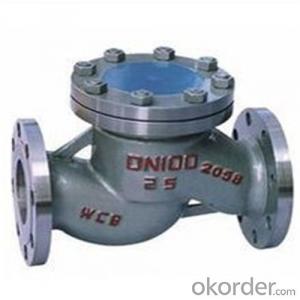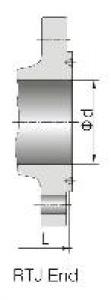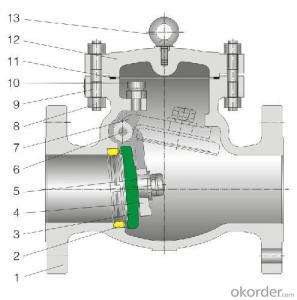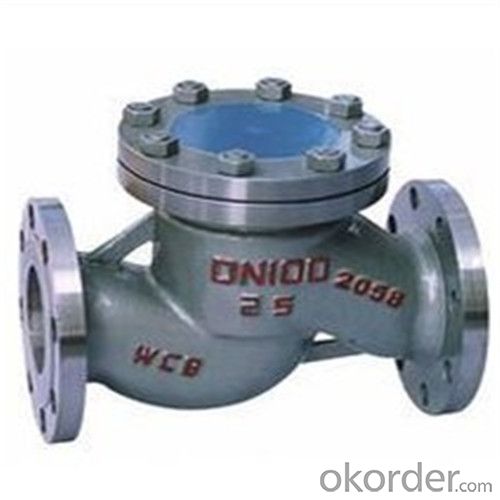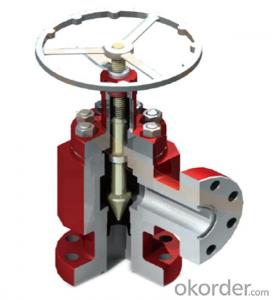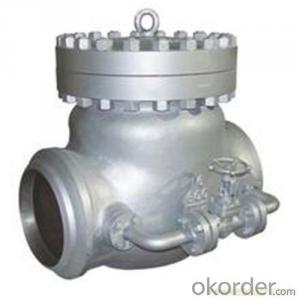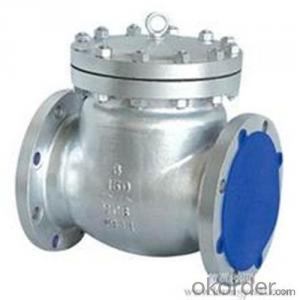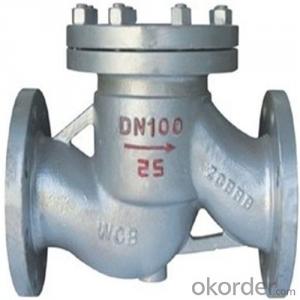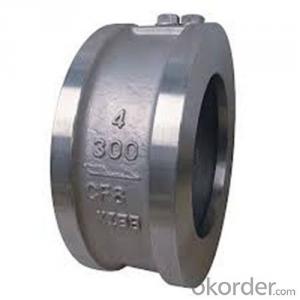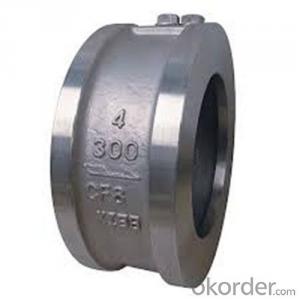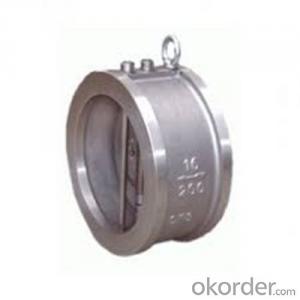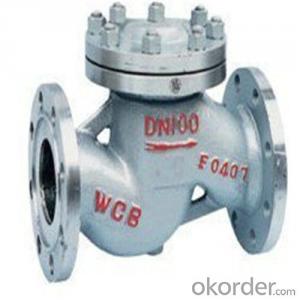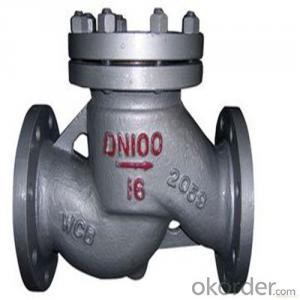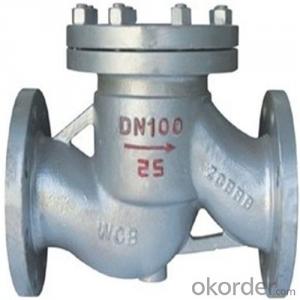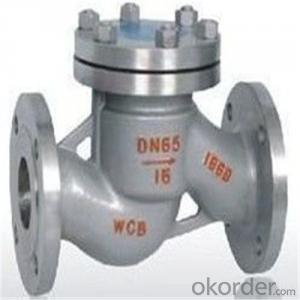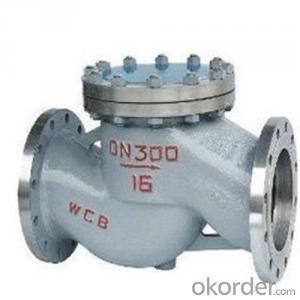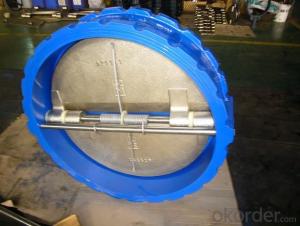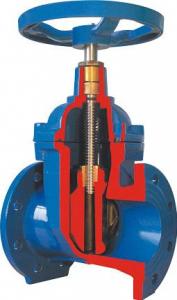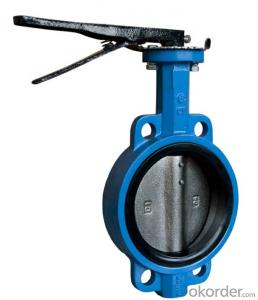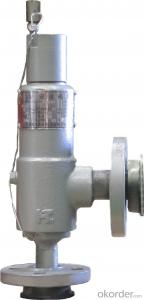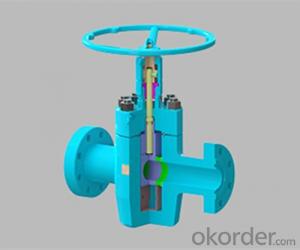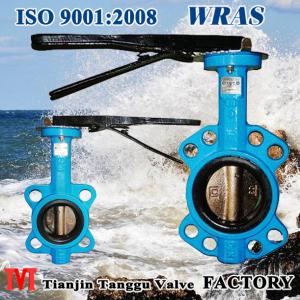API Cast Steel Lift Check Valve Size 125 mm
- Loading Port:
- Shanghai
- Payment Terms:
- TT OR LC
- Min Order Qty:
- 10 pc
- Supply Capability:
- 100 pc/month
OKorder Service Pledge
OKorder Financial Service
You Might Also Like
API Cast Steel Lift Check Valve 150 Class
The features of Cast Steel Lift Check Valve
Bolted Bonnet;Swing and lift disc;Metallic seating surfaces.
Body and Bonnet Connection of Cast Steel Lift Check Valve:
The body and bonnet of Class150~Class900 check valves are usually with studs and nuts.And the body and bonnet of Class1500~Class2500 check valves are usually of pressurized seal design.
Body-To-Bonnet Joint of Cast Steel Lift Check Valve:
Stainless steel + flesible graphite wounded gasket is used for Class 150 and Class 300 check valve;Stainless steel + flexible graphite wounded gasket is used for Class 600 check valve,and joint gasket is also optional for Class 600 check valve;Ring joint gasket is used for Class900 check valve;Pressurized seal design is used for Class 1500~Class 2500 check valves.
Seat of Cast Steel Lift Check Valve:
For carbon steel check valve,the seat is usually forged steel.The sealing surface of the seat is spray welded with hard alloy specified by the customer.Renewable threaded seat is used for NPS<10 check="" valves="" and="" welded="" on="" seat="" can="" be="" also="" optional="" if="" being="" requested="" by="" the="" customer.welded="" is="" used="" for="" nps="">12 crbon steel gate valves .Forstainless steel check valve,integral seat is usually adopted ,or to weld hard alloy directly integrally.Threaded or welded on seat is also optional for stainless steel check valve if being requested by the customer.
Parameter of Cast Steel Check Valve:
Standard Criteria | ASME/ANSI/API customize |
Pressure Rating | 150 Class 300 Class 600 Class 900 Class 1500 Class 2500 Class customize |
Valve Size | 50 mm 65 mm 80 mm 100 mm 125 mm 150 mm 200 mm 250 mm 300 mm 350 mm 400 mm 450 mm 500 mm 600 mm 650 mm 700 mm 750 mm |
2 inch 2.5 inch 3 inch 4 inch 5 inch 6 inch 8 inch 10 inch 12 inch 14 inch 16 inch 18 inch 20 inch 24 inch 26 inch 28 inch 30 inch customize | |
Actuator | Automatic customize |
Connection | Butt Welding Flange RF Flange RTJ customize |
1-Body Material | A216 WCB A351-CF8 A351-CF8M customize |
2-Seat ring | A351-CF8 A351-CF8M A105+13Cr Tool Steel+A105 customize |
3-Disc | Tool Steel+A216 WCB A351-CF8M A351-CF8 A216 WCB+13Cr customize |
4-Arm | A351-CF8 A216 WCB A351-CF8M customize |
5-Nut | A194 8M A194-8 A194 2H customize |
6-Arm pin | A182-F6a A182-F316 A182-F304 customize |
7-Yoke | A351-CF8 A351-CF8M A216 WCB customize |
8-Bonnet nut | A194 8M A194-8 A194 2H customize |
9-Bonnet bolt | A193-B8 A193-B8M A193-B7 customize |
10-Bolt | A193-B7 A193-B8 A193-B8M customize |
11-Gasket | graphite+304 graphite+316 customize |
12-Bonnet | A216 WCB A351-CF8M A351-CF8 customize |
13-Eye bolt | A181 customize |
Design Standard | API 6D BS 1868 customize |
Connection Standard | API 605 ASME B 16.25-2007 ASME B 16.47A ASME B 16.47B ASME B 16.5 MSS SP-44 customize |
Test Standard | API 598 API 6D customize |
Face to Face | ASME B 16.10 customize |
Pressure-temperature ratings | ASME B 16.34-2004 customize |
Wall thickness dimension | API 600 BS 1868 |
FAQ of Cast Steel Check Valve:
Q1:I can’t find the type of steel check valve which I need. what can I do?
The chart above only lists out some common composition of steel check valve parts.We may provide other different parts material composition according to the customer's request or the actual valve working condition.
Q2:Which certification do your products pass?
Our products are in accordance with ISO 9001、ISO 14001、API 6A、API 6D、TS CE、API607/6FA/BS6755.
- Q: I have a curtis toledo compressor at my house. While moving it a helper dropped it on its side into the tank and broke off these 2 valves off the very top of the compressor. They had a copper line that ran off both of them and went over to the auto on/off switch, I'm guessing that's what it is. Where can I buy these or at least what are they called?
- They are the unloader valves. Look online for places that sell parts for air compressors.
- Q: I have a Jupiter double horn. The thumb valve will randomly stick down and not want to come back up. It however only does this when I play a scale or am in the middle of a song, so when I ask the director or an instrument repair person to help, they think I'm crazy and see nothing wrong with it. Also, the first valve is slightly bent sideways towards the second valve. I got it used and it came like this. It is not horrible, but that makes it significantly slower than the other valves and sticks a LOT. All repair shops do is take my money and claim they've fixed it when they have done nothing. It is so frustrating. What should I do? And the oil doesn't help with either of these things, which is even MORE frustrating.
- Open up the #4 valve cap and flood the top with valve oil, put the cap back on and turn the instrument over. Put valve oil in the crack where the valve comes out of the bottom of the valve case. This can be hard to see. Put some drops on every moving part of the valve action. I can remember the layout of that valve but I don't think you can shoot oil into the valve. Try all that I said above and see if that helps. Rotate and wiggle the valve between each step.
- Q: Can someone please help me on this anatomy question:Describe the physical similarities and differences in the structure of the AV valves and the semilunar valves.Thanks
- av valves are anchored to the wall of the ventricle by chordae tendinae, multicusped valves while semilunar valves do not have chordae tendinae, but are more similar to valves in veins. positioned on the pulmonary artery and the aorta both have the same function of prevent backflow of blood
- Q: My pressure reducing valve has gone bad. This looks like a pretty simple change. My question is do i loosen the union nut first (after draining water line), then loosen the whole valve??? Then reverse to install??? Any info would be great....
- some reducing valves are adjustable. if this one has a locknut witha screw on good thats probable the explanation for loss of psi. via turning the screw in you advance the psi. if it has no screw examine the score on it. you like 60-a hundred psi variety. if nonetheless no answer do away with the valve and see if sturdy rigidity comes out of the meter. its a fashion of removal and a splash attempt. it particularly is the meter. you may troubleshoot its one or the different.
- Q: How many valves are involved in th etypical 4-stroke cycle? Is it the intake and exhaust valves only? If my car engine has 12 valves, how many cylinders does it have?
- nowadays usually it's four valves per cylinder, though still u may find 2 valves per cylinder. u cann't know how many cylinders u have from knowing the number of valves, it depends on the design.
- Q: My 10 year old boy was diagnosed with a leaking heart valve yesterday.The Doctor is trying to get him in to see a specialist asap.She didn't seem that concerned with it,but I don't know if she was just trying to keep us calm about it.How serious is this,and is surgery the only way to fix it,or do they have meds for this condition.
- If the medical doctors say might, then he ought to get his valve mounted in might. think of approximately it. you could stay with purely area of your liver, purely one kidney, and you will possibly be able to stay devoid of your gall bladder. yet you could not stay devoid of your coronary heart, all muscle groups and chambers and valves! it particularly is not a sturdy time for him? What ought to probable be greater significant than getting his coronary heart mounted?
- Q: I've never replaced a shut off valve before but am wondering if there are any tricks in freeing up a stuck valve that wont close. Can this be done so I don't have to call anybody?
- When valves are turned all the way in an open position they tend to get stuck. Try a heat gun but make sure you have a copper line feeding into the toilet tank, not a plastic one because it can melt. Just heat the valve for a few minutes at a time, because over heating it can damage the rubber washer inside the valve. If all fails then it has to be replaced by someone who is knowledgeable.
- Q: need a different pump for? Is this some improvement on the old valve?
- Dita is correct. You do not need a new pump. Most of the new ones (ones you'd find at a bike shop, probably not Wal Mart pumps), will handle both. The newest ones have a smart head where you just plug in the valve, flip the lever, and the pump figures out which valve stem you have. On slightly older pumps, it is a matter of switching the pump head internals around. On the really old pumps (or really cheap ones), you need a brass or alloy adapter that threads onto the presta valve and converts it to schrader.The schrader valve uses a spring to close the valve to prevent air loss. Presta uses the air pressure itself to seal the valve.
- Q: And' the valve leaks......Can the valve be unscrewed from the tank for replacement? Or can the valve be serviced with a new gasket perhaps?
- i would not worry about replacing the wsher inside the valve...U can go to about any home improvement store and just buy a new valve for around $10...so if they have a quarter turn valve...those will serve u best in the future plus it is a ball valve which doesnt use a washer but a ball inside turn so it is a better seal...just drain the water heater then unscrew the old one and put pipe sealant on the thread of the new one and just screw it back in and fill ur water heater back up and ur done..
- Q: Do most V6's have 24 valves? What are they for? (brief description would be fine)
- Valves in an engine have two purposes. There is a set of valves to let the air/fuel mixture IN to the engine cylinders. Those valves then close, sealing the gas in for combustion. Once the fuel has burned, the outlet valves open and let the spent fumes out through the exhaust. Cars and trucks usually have 2-4 valves per cylinder. So, in a V6 with 6 cylinders, there could be anywhere from 12 valves to 24 valves. More valves typically mean that the engine can produce more power and be more efficient.
Send your message to us
API Cast Steel Lift Check Valve Size 125 mm
- Loading Port:
- Shanghai
- Payment Terms:
- TT OR LC
- Min Order Qty:
- 10 pc
- Supply Capability:
- 100 pc/month
OKorder Service Pledge
OKorder Financial Service
Similar products
Hot products
Hot Searches
Related keywords
